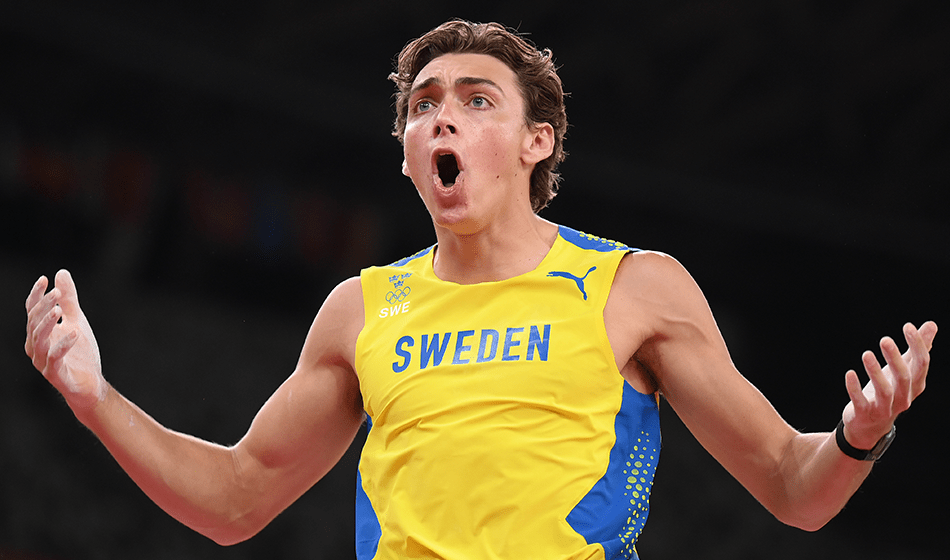
Mondo Duplantis makes it look so simple but there’s so much an athlete has to do to propel themselves into the sky and over a bar, as coach Scott Simpson explains
Legend has it that pole vaulting was invented by shepherds who, needing to cross a river in pursuit of their sheep, propelled themselves over by swinging on a long stick. The essentials have not changed. You grab a thick, flexible pole, run down a runway as fast as you can, jam the pole into a hole in the ground, allowing it to bend, and then let it catapult you in the air before having to navigate your way over a crossbar. By the way, the crossbar just happens to be the same height as a two-storey house!
The key skills
The key requirements for pole vault can be broken down into three key areas: technical, physical and mental. You have to be very skilful and very athletic in order to handle an implement and also manipulate your own body weight. You need gymnastic awareness to use that implement to navigate your way through the vault.
There’s a huge physical component as well. Speed is fundamental but so is agility, including gymnastic agility.
The third aspect is mental – you need to be brave, mentally very strong and prepared to put your life on the line every time you run and plant the pole. Pole vault is a dangerous event which may appeal more to daredevil personality types. You have to be willing to take risks.
An event for all sorts
One of the beauties of the event is that you can be very successful with an assortment of different physical qualities. There are some very tall vaulters. Jenn Suhr (former Olympic and world indoor champion) is over 6ft tall. Martina Strutz (2011 world silver medalist in 2011) is perhaps 5ft 1in but still vaulted 4.80m.
In the men’s event there has been a change from the big athletes like some of the Russians or Steve Hooker and Piotr Lisek to quite small, athletic men like Renaud Lavillenie and Mondo Duplantis who, although weighing under 75kg, are finding a way to be successful. So there are many ways to achieve success in pole vault.
Marina Strutz vaulting over the pole in 2011 (Getty)
The pole
Poles come in different lengths and different levels of stiffness. A vaulter can select any length of pole they want to. Logic would tell you that the longer the pole you use, the higher you will jump, in the sense that the higher you are gripping the pole, when it is in the vertical position, the higher in the air you will be – but it’s not that simple!
When you take off, the pole is not in a vertical position but a horizontal position and you have to rotate it to the vertical and a longer lever rotates more slowly. So the longer the pole you use, the faster you need to be, to rotate it to the vertical.
The compromise is to use the longest pole possible which is within the limits of your physical ability to rotate it up to the vertical position. Otherwise, instead of landing on the mat you land on the track, which is hazardous to say the least.
The other variable with poles is the resistance rating. One way of measuring that is how far the pole deflects from its original position when you hang a weight from it between two pivots. The bigger the number, the softer (more sag) and more flexible the pole is, because it bends more with weight on it.
If the pole deflects less, that means it is stiffer and has a lower number. For example a 12-rated pole is stiffer than a 14-rated pole. The pole is individually selected, based on the athlete’s physical attributes and technical skill but also taking into account their bodyweight and other variables. Vaulters will typically have several poles of differing lengths and stiffness, changing poles as the competition progresses.
The run-up
The maximum runway distance available to vaulters is normally 45m. Athletes are typically choosing a run-up of between 14 and 20 strides in which to build up an optimal amount of speed. It’s important when you get to the take-off point that you are at optimum speed and not decelerating.
But, alongside maximum speed, you also have to have accuracy. In the same way that a long jumper has to hit the take-off board, the vaulter has to hit the take-off mark. You have to be in the right posture (very tall) to take off effectively and you also have to get the pole in the right position.
At the start of the run-up the pole is held vertically because it’s almost weightless in that position but, by the time you get to the other end of the runway, the pole has to be re-positioned down to the horizontal and your hands put above your head for take-off. There’s a lot going on during the run-up!
To give you examples; up until 2020, Harry Coppell jumped from 16 strides but this year we’ve moved him back to an 18-stride approach in the hope that it will give him a little bit more speed. It has given him more speed but that has brought its own challenges because he has had more variability in his approach run and at first he struggled on the run because of the extra distance and extra speed that he was getting.
Holly Bradshaw uses a “walk on”, as opposed to a static start and she walks onto a 14-stride approach. She has previously experimented with both 12 and 16-stride approaches, but we have found that the optimal length for her, getting the balance between speed and consistency, is 14 strides.
Holly Bradshaw (Mark Shearman)
The take-off
The last couple of strides of the run-up are about re-positioning the pole from your waist to above your head; what we call “planting the pole”. This is done while trying not to lose any speed but also getting ready to jump off the ground because there’s no point in just running into the pole; you have to jump onto the pole.
A number of different factors are all coming together at that moment. The combination of planting the pole, preparing to jump and maximizing the speed essentially gives you the opportunity to transfer energy effectively into the pole. The more efficiently you can do those three things in a co-ordinated manner, the better your take-off will be. The athletes who do that best are typically the most successful.
Attacking the take-off
It’s kind of like a tackle in rugby. If you are passive and defensive in that moment and allow the oncoming player to hit you, the chances are that you’ll come off worse. The better way to deal with that collision is to attack right into the tackle. In the same way you need to attack the pole in the last few strides. If you do that effectively, you win the battle with the pole. If you are passive, and you don’t attack the take-off then you’re likely to be smashed by the pole… and that never ends well.
Getting over the bar
This is where the event gets really technical, but explained simply: the pole is going to bend. With someone like Lavillenie, it bends a lot. As the pole is bending, the athlete has to try to swing their body in such a way that they reposition themselves on top of the bend as it reaches the maximum bend point because you don’t want to still be underneath the bend at that point. If the athlete does that, as the pole recoils it effectively catapults them towards the bar. Finding that swinging action as the pole is bending requires a lot of skill but also requires a lot of bravery to commit to it.
Renaud Lavillenie (Mark Shearman)
A vaulter’s training programme
The event is a 35-45m sprint followed by a jump at the end of it and some gymnastics on the pole. The athlete has to be able to do that six to 12 times in a competition. That is what we have to become very good at so our training reflects that.
We do some general training because of the need of general athleticism. In particular in the off-season, we go to a gymnastics centre once or twice a week. We do some tempo running for fitness, some yoga for mobility, but for athletes like Holly and Harry it’s quite a small percentage of what they do.
We don’t pole vault as much as people might think; not more than twice a week, because of the demands it puts on the body. We do some sprinting, running with a pole, work in the weights room to develop specific qualities which are relevant to pole vaulting. Most of the training is focused on the needs of the event and of the individual athletes. There’s only a small amount that I would describe as general fitness.
Scott Simpson is a former international pole vaulter. In recent years he has been National Performance Institute Senior Coach for pole vault and he is personal coach to a number of athletes including Harry Coppell and Holly Bradshaw.
Scott Simpson was speaking to Stuart Weir















 Phone: (800) 737. 6040
Phone: (800) 737. 6040 Fax: (800) 825 5558
Fax: (800) 825 5558 Website:
Website:  Email:
Email: 






